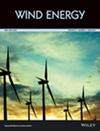全尺寸风力涡轮机叶片监测活动的可行性研究:比较从中频主动振动中提取的特征的性能和稳健性
IF 3.3
3区 工程技术
Q3 ENERGY & FUELS
引用次数: 0
摘要
本文研究了从振动数据中提取的不同特征的性能,用于52米风力涡轮机叶片在疲劳测试期间的结构健康监测。在测试过程中,使用了主动振动监测系统,在中频范围内提供周期性的单频激励,并使用加速度计测量叶片不同部位的振动输出。基于作者之前的工作,可以获得风力涡轮机叶片在健康状态、人工引起的损伤和逐渐增加的损伤严重程度的数据。利用振动数据,采用不同的信号处理方法提取损伤敏感特征。时间序列方法和时频域方法用于量化应用的主动振动信号。采用离群值分析方法对叶片的健康状态进行分类,并对不同特征的分类精度进行比较。使用自回归参数作为特征,通过对振动输出进行自回归建模,通常可以获得最高的性能。最后,对该方法在实际应用中的改进提出了建议。本文章由计算机程序翻译,如有差异,请以英文原文为准。
Feasibility study on a full‐scale wind turbine blade monitoring campaign: Comparing performance and robustness of features extracted from medium‐frequency active vibrations
The present work investigates the performance of different features, extracted from vibration‐based data, for structural health monitoring of a 52‐meter wind turbine blade during fatigue testing. An active vibration monitoring system was used during the test campaign, providing periodic excitation of single frequencies in the medium‐frequency range, and using accelerometers to measure the vibration output on different parts of the blade. Based on previous work from the authors, data is available for the wind turbine blade in healthy state, with a manually induced damage, and with progressively increasing damage severity. Using the vibration data, different signal processing methods are used to extract damage‐sensitive features. Time series methods and time‐frequency domain methods are used to quantify the applied active vibration signal. Using outlier analysis, the health state of the blade is classified, and the classification accuracy through use of the different features is compared. Highest performance is generally obtained by auto‐regressive modeling of the vibration outputs, using the auto‐regressive parameters as features. Finally, suggestions for future improvements of the present method toward practical implementation are given.
求助全文
通过发布文献求助,成功后即可免费获取论文全文。
去求助
来源期刊

Wind Energy
工程技术-工程:机械
CiteScore
9.60
自引率
7.30%
发文量
0
审稿时长
6 months
期刊介绍:
Wind Energy offers a major forum for the reporting of advances in this rapidly developing technology with the goal of realising the world-wide potential to harness clean energy from land-based and offshore wind. The journal aims to reach all those with an interest in this field from academic research, industrial development through to applications, including individual wind turbines and components, wind farms and integration of wind power plants. Contributions across the spectrum of scientific and engineering disciplines concerned with the advancement of wind power capture, conversion, integration and utilisation technologies are essential features of the journal.
 求助内容:
求助内容: 应助结果提醒方式:
应助结果提醒方式:


